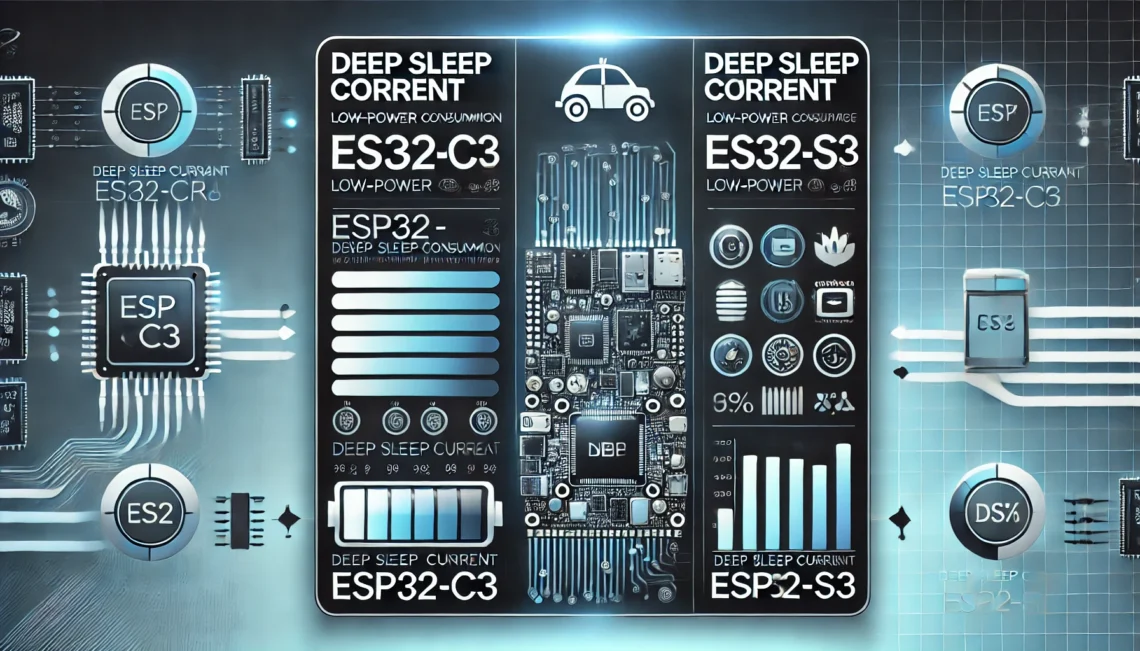When it comes to low-power microcontrollers, the ESP32 series by Espressif Systems stands out due to its versatility, performance, and energy efficiency. Two of the popular variants in the ESP32 family are the ESP32-C3 and ESP32-S3. Both of these microcontrollers offer excellent features for Internet of Things (IoT) applications, but when it comes to battery-powered projects, one of the most important considerations is deep sleep current consumption.
In this article, we will dive into a detailed comparison of ESP32-C3 vs ESP32-S3 deep sleep current consumption, exploring their differences, performance characteristics, and practical applications for battery-powered devices.
What is Deep Sleep Mode in ESP32?
Before comparing the two variants, let’s first understand what deep sleep mode is and why it’s essential.
Deep sleep mode is a low-power state that a microcontroller enters when it’s not actively performing any tasks. In this mode, most of the microcontroller’s components are powered down, but it can still wake up based on certain triggers, such as a timer or external interrupt. This makes deep sleep mode an ideal solution for applications where energy efficiency is crucial, such as in battery-operated IoT devices.
Both the ESP32-C3 and ESP32-S3 feature deep sleep modes that help to minimize power consumption, but they may vary in terms of how efficiently they use power during this state.
ESP32-C3 vs ESP32-S3: Overview of Key Features
Before we get into the deep sleep comparison, it’s important to quickly look at the main differences between the ESP32-C3 and ESP32-S3 microcontrollers:
- ESP32-C3:
- Architecture: RISC-V core
- Wireless: Wi-Fi 4 (802.11 b/g/n), Bluetooth 5.0 LE
- Clock Speed: Up to 160 MHz
- Flash: Supports external flash up to 16MB
- GPIOs: Up to 22 GPIOs
- Applications: Great for low-power IoT devices, wearables, and smart sensors.
- ESP32-S3:
- Architecture: Xtensa® 32-bit LX7 core
- Wireless: Wi-Fi 4 (802.11 b/g/n), Bluetooth 5.0 LE
- Clock Speed: Up to 240 MHz
- Flash: Supports external flash up to 16MB
- GPIOs: Up to 45 GPIOs
- Applications: Ideal for AI, machine learning, and more computationally demanding tasks in IoT.
Both chips offer advanced features, but in terms of deep sleep current consumption, we are primarily concerned with the power-saving capabilities of these microcontrollers when they are not actively performing tasks.
Deep Sleep Current Consumption: ESP32-C3 vs ESP32-S3
1. ESP32-C3 Deep Sleep Current:
The ESP32-C3 is designed with energy efficiency in mind, especially for simple IoT applications that require low power consumption. Here are the key points about its deep sleep current:
- Typical Deep Sleep Current: The ESP32-C3 typically consumes around 6 µA in deep sleep mode when the chip is fully powered down and only essential components remain active (like the RTC for wake-up triggers).
- Key Features Impacting Power Consumption: The ESP32-C3 is equipped with a low-power RISC-V core, which ensures it is power-efficient. Additionally, it allows for various power management features, such as turning off the Wi-Fi and Bluetooth radios in deep sleep.
- Optimal for Low Power: The ESP32-C3’s deep sleep current of 6 µA makes it ideal for low-power applications like wearables, remote sensors, or other battery-operated devices that require long battery life.
- Wake-Up Time: When the device wakes from deep sleep, it takes about 5 ms for the ESP32-C3 to resume normal operation.
2. ESP32-S3 Deep Sleep Current:
The ESP32-S3, while more powerful and feature-rich than the ESP32-C3, also offers excellent deep sleep capabilities. Here’s how it compares:
- Typical Deep Sleep Current: The ESP32-S3 has a slightly higher deep sleep current of around 15 µA. While this is still very low, it is higher than the ESP32-C3’s deep sleep consumption.
- Key Features Impacting Power Consumption: The ESP32-S3 features a more powerful LX7 core and additional AI/ML capabilities, which require slightly more power. However, it also has an efficient power management system that can switch off the Wi-Fi and Bluetooth radios to save power.
- Optimized for Performance and Power: While the ESP32-S3 has a higher deep sleep current than the ESP32-C3, it is still a great choice for applications where performance (especially in AI and machine learning) is prioritized, and moderate power consumption is acceptable.
- Wake-Up Time: Like the ESP32-C3, the ESP32-S3 has a fast wake-up time of around 5 ms, allowing quick resume from deep sleep.
Comparing ESP32-C3 vs ESP32-S3: Power Consumption in Detail
When evaluating the power consumption of both chips in deep sleep mode, here are some factors to consider:
| Feature | ESP32-C3 | ESP32-S3 |
|---|---|---|
| Deep Sleep Current | 6 µA | 15 µA |
| CPU Architecture | RISC-V Core | Xtensa LX7 Core |
| Power Consumption | Lower for simple tasks | Slightly higher due to AI/ML capabilities |
| Wireless Modules Off | Yes (Wi-Fi and Bluetooth) | Yes (Wi-Fi and Bluetooth) |
| Power Management Features | Efficient, low-power design | Efficient, with additional features |
| Wake-Up Time | ~5 ms | ~5 ms |
While the ESP32-C3 draws significantly less current in deep sleep, the ESP32-S3 is still quite efficient and ideal for more demanding applications where additional performance is needed.
Applications and Use Cases
Here’s a breakdown of ideal use cases for each of the chips:
- ESP32-C3:
- Low-Power IoT Devices: Perfect for small, battery-powered IoT sensors and devices where the primary focus is on power efficiency.
- Wearables: Due to its lower deep sleep current, the ESP32-C3 is highly suited for wearable devices that need to run on small batteries for extended periods.
- Remote Sensors: Sensors that only need to transmit data periodically and operate on a tight power budget.
- ESP32-S3:
- AI and Machine Learning: With more processing power, the ESP32-S3 is great for applications that require AI capabilities, such as voice recognition or image processing, but also need energy efficiency.
- Smart Home Devices: Devices that require a balance of power consumption and computational power, such as smart cameras, lights, or assistants.
- Portable Devices: If the device needs to perform more tasks without compromising battery life, the ESP32-S3 is an excellent choice.
How to Optimize Deep Sleep Power Consumption?
Whether you are using the ESP32-C3 or ESP32-S3, here are a few tips for optimizing deep sleep current:
- Turn Off Peripherals: Ensure that non-essential peripherals (e.g., Wi-Fi, Bluetooth, sensors) are turned off during deep sleep.
- Use the RTC: Use the Real-Time Clock (RTC) to wake up the device at specific intervals, which helps reduce unnecessary power usage.
- Adjust Sleep Modes: Depending on your application, you can adjust sleep modes to balance power consumption and wake-up requirements.
Conclusion: Which is Better for Low Power?
When comparing the ESP32-C3 vs ESP32-S3 deep sleep current, the ESP32-C3 stands out for its ultra-low current consumption (6 µA), making it ideal for applications where power efficiency is the top priority. However, the ESP32-S3 offers slightly higher deep sleep consumption (15 µA) but delivers greater processing power and additional features like AI/ML capabilities, making it better suited for applications that need more computational resources.
Both microcontrollers are highly efficient and can be used in battery-powered IoT devices, but the choice ultimately depends on the balance between power consumption and the need for performance. If energy efficiency is paramount, the ESP32-C3 is the better option. If you need more performance for AI-driven tasks without a significant increase in power usage, the ESP32-S3 is the ideal choice.
Ultimately, both chips provide excellent deep sleep features, and by understanding the deep sleep current requirements, you can choose the best microcontroller for your specific application.
Frequently Asked Questions (FAQs)
What is the difference in deep sleep current between ESP32-C3 and ESP32-S3?
The ESP32-C3 has a deep sleep current of about 6 µA, while the ESP32-S3 consumes around 15 µA in deep sleep mode.
Which ESP32 variant is best for low-power applications?
The ESP32-C3 is better suited for low-power applications due to its lower deep sleep current.
Can I use both ESP32-C3 and ESP32-S3 in battery-powered devices?
Yes, both are suitable for battery-powered applications, but the ESP32-C3 is more efficient for strictly low-power tasks.
How can I reduce deep sleep power consumption in ESP32?
Turn off non-essential peripherals, use the RTC for wake-up scheduling, and choose the right sleep modes based on your requirements.




